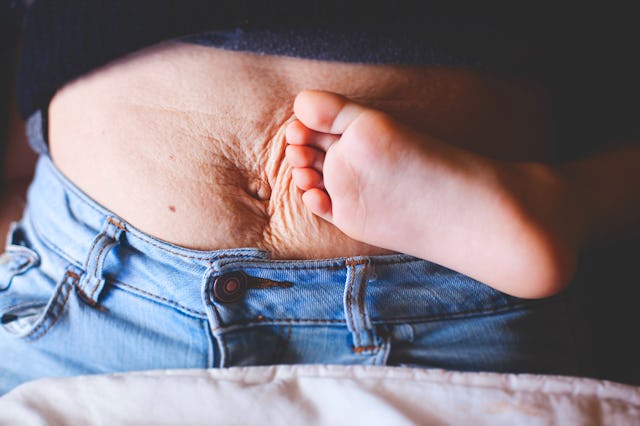A Guide To The C-Section Shelf, AKA A Postpartum "FUPA"
Give yourself — and your body — some time.

There is nothing quite as miraculous as the human body. Not only can it create an actual person from scratch, but it also provides said baby with nutrition immediately after it’s born. Talk about impressive! And yet, despite all of that, there remains a great deal of scrutiny surrounding postpartum bodies. Instead of marveling at what the body can do, many tend to focus on what it should look like, according to society’s standards. (As if new mothers needed another thing to worry about.) It isn’t fair, but because of this pressure, we often end up being our own harshest critic — whether it’s feeling the need to get back to your exercise routine ASAP or grappling with the infamous c-section shelf.
That latter term may sound unfamiliar to many of you, particularly those who have only experienced a vaginal birth. However, a c-section shelf — or rather a “c-section pooch,” as it’s sometimes colloquially referred to — can be an unexpected and surprising side effect to cesarean birth. If this is something you can relate to, you are not alone.
Here’s everything about the c-section shelf you need to know.
What is a c-section shelf exactly?
Basically, it’s any excess skin and/or fat — formed from your previously pregnant belly — that hangs off of your c-section scar, creating an almost shelf-like appearance (hence the name).
What causes the c-section shelf?
As mentioned, a lot of it is due to excess skin and fat created during pregnancy. As your belly grew, your skin expanded with it to make room. Now that the baby is out, there’s nowhere for that extra skin to go. (We’re not made of elastic, after all!) So, naturally, some of that skin sits on top of your c-section scar like a little pouch. Additionally, scar tissue from the surgery can also factor into the equation, making said pooch/pouch even more prominent.
Does the c-section shelf ever go away?
Honestly, it depends. No two postpartum tummies are the same. Some bodies are able to bounce back quicker than others, while some bodies end up being forever changed. Gently massaging the area can potentially help over time, and, of course, postpartum exercises may help move the process along to some degree — so long as you’ve gotten your doctor’s approval to do so. But truth be told, there’s no guarantee that the so-called “shelf” will completely disappear. It could take weeks, months, or years. Or it could never go away entirely.
What can I do about it?
Here’s the thing: Your body just did something incredible. Your postpartum body isn’t something to be fixed. It is beautiful and amazing and something to be celebrated. However, if saying goodbye to that pooch is something that you want for yourself, by all means, you do you. There’s no tried-and-true way to get rid of a c-section shelf, but establishing a smart and safe postpartum workout routine is a step in the right direction. Since you’ll need your doctor’s clearance to work out after your surgery anyway, you can always ask them for advice about exercises and tips to target your shelf.
Another factor to consider: time. It’s just going to take time for your body to calibrate from, you know, creating a human being. Give yourself some time. Give your body some time. You’ve both more than earned it.
And take care of yourself! The only thing you should be doing about your C-section shelf is making sure you're recovering from your actual c-section. A few tips to follow post cesarian are rest, rest, and rest. Do not lift any heavy objects or really anything heavier than the baby. The first few weeks of motherhood are hectic but do not forget to eat. And if you feel so compelled to exercise, skip the aggressive workouts and take short walks instead.
But if your FUPA really bothers you, here are a few of low-stress activities you can do to make it a little flatter. It won't happen overnight, but it'll help make a difference.
- Massage your c-section scar: This activity aims to break down the scar tissue to reduce the bloated appearance. It's a great way to help smooth things out.
- Add skin-tightening foods to your diet: Eat foods high in Vitamin C, zinc, or that have lots of garlic in them. This will help boost your collagen and elastin production.
- During your short walks, wear a workout waist wrap: This targets the tummy and helps you get a good sweat around that area. Avoid the corset, rib-crushing waist wraps. A loose one is just as effective.
A final approach? Doing absolutely nothing. You don’t have to prove anything to anyone. Embrace the new you, c-section shelf and all! That’s what Beyoncé did, after all, while speaking about her post-pregnancy body in the 2018 September issue of Vogue.
“I embraced being curvier. I accepted what my body wanted to be. After six months, I started preparing for Coachella. I became vegan temporarily, gave up coffee, alcohol, and all fruit drinks. But I was patient with myself and enjoyed my fuller curves. My kids and husband did, too,” she stated, referring to the c-section she underwent while giving birth to her twins Rumi and Sir back in June 2017. “To this day, my arms, shoulders, breasts, and thighs are fuller. I have a little mommy pouch, and I’m in no rush to get rid of it. I think it’s real. Whenever I’m ready to get a six-pack, I will go into beast zone and work my ass off until I have it. But right now, my little FUPA and I feel like we are meant to be.”
So, listen to Queen Bey and give your body the praise it deserves!
This article was originally published on